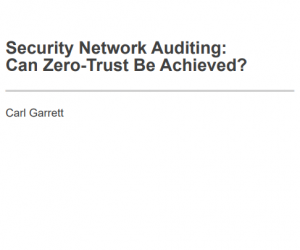
Sorry, your browser is not compatible with this application. Please use the latest version of Google Chrome, Mozilla Firefox, Microsoft Edge or Safari.
Security Network Auditing: Can Zero-Trust Be Achieved?
Since 2010, government and business organizations have begun to adopt the Zero-Trust framework. Although the concept is a decade old, organizations are still in the infant stages of its implementation. Given that tablets and mobile phones have become an intricate part of business aids, all organizations will eventually integrate Zero-Trust into their environments. Many third-party vendors market Zero-Trust tools; though, they only provide one or two pieces to achieve “true” Zero-Trust.
Designing a security auditing Zero-Trust framework, professionals must use a layered approach to defense-in depth. They must also understand the principle of Least Common Mechanism because complicated information technology systems are challenging to control. In traditional perimeter networks, users must authenticate to an entire organizational network, where perimeter-less Zero-Trust networks are segmented; thus, users can log on a Zero-Trust network by accessing a single-segment at a time. This technology eliminates the need for virtual private networks (VPN), thus, providing faster access.

| Format: |
|
| Topics: | |
| Website: | Visit Publisher Website |
| Publisher: | The SANS Institute |
| Published: | September 23, 2020 |
| License: | Copyrighted |
| Copyright: | © 2000-2020 SANS™ Institute |
Featured Content

Contact Publisher


Claim Content





